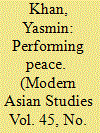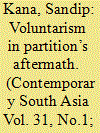| Srl | Item |
| 1 |
ID:
102042


|
|
|
|
|
| Publication |
2011.
|
| Summary/Abstract |
The consolidation of the Nehruvian state's sovereignty after Independence is traced here as a contingent event which was tightly linked to the impact of Gandhi's assassination and the mourning rituals which followed his death in 1948. The Congress was able to use the funeral, mortuary rituals and distribution of Gandhi's ashes to assert the power of the state and to stake the Congress Party's right to sovereignty. This intersected with localized and religious expressions of grief. Gandhi's death therefore acted as a bridge, spatially and temporally linking the distant state with the Indian people and underscoring transitions to Independence during the process of postcolonial transition from 1947-1950.
|
|
|
|
|
|
|
|
|
|
|
|
|
|
|
|
| 2 |
ID:
192296


|
|
|
|
|
| Summary/Abstract |
This article adopts an alternative framework for thinking about the Nehruvian state and the drivers that shaped India’s postcolonial development strategy. This is a firm shift away from viewing development as a technocratic enterprise, and towards a focus on how the Nehruvian state sought to deploy notions of voluntarism. Within the Indian context, voluntarism referred to the mobilisation of ordinary people to further local development projects. This article investigates voluntarism through efforts at rehabilitating able-bodied refugees in Faridabad. Like many refugee townships that were constructed in the immediate aftermath of Partition, Faridabad was built from the ground up entirely through reskilled able-bodied refugee labour. Within the environment of rehabilitation, the article shows how voluntarism through the cooperative model became an integral postcolonial development strategy adopted by the Nehruvian state to construct new distinct urban spaces on formerly uncultivated lands. However, the article will reveal how the Nehruvian state’s use of voluntarism was beset with tensions, challenges, and problems. The article shows how widespread refugee discontent, bureaucratic mismanagement and alleged financial misconduct ultimately impeded the Nehruvian vision of empowering and mobilising ordinary Indians to further projects of public utility.
|
|
|
|
|
|
|
|
|
|
|
|
|
|
|
|